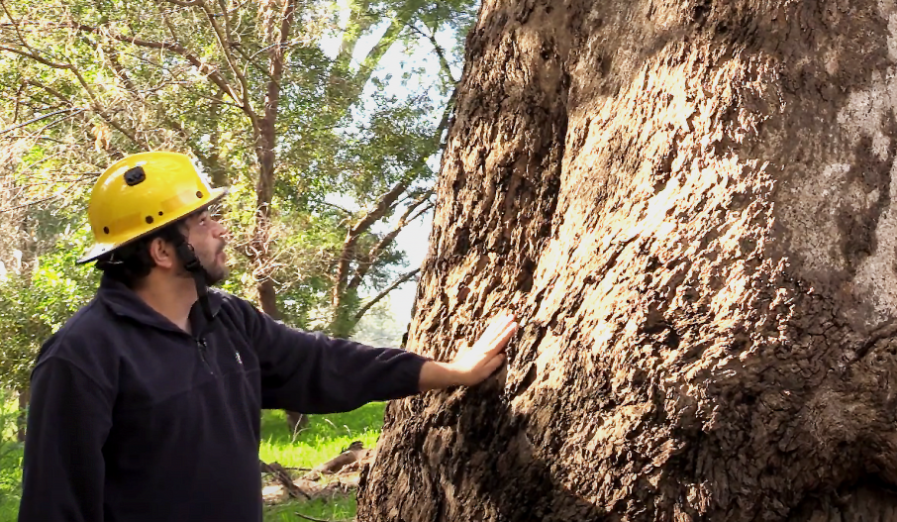 Aboriginal Cultural Heritage Adviser Michael Sherwen / Video still
Aboriginal Cultural Heritage Adviser Michael Sherwen / Video still
Planted trees and gardens are an important feature of most communities to commemorate and remind us of our local history. Many native plantings have significance for Aboriginal communities. These important trees are often the last remaining markers of former natural and cultural landscapes.
Culturally significant trees provide valuable clues about where and how Aboriginal people used to live and the use of perishable materials.
Aboriginal people caused scars on trees by removing bark for various purposes.
The scars, which vary in size, expose the sapwood on the trunk or branch of a tree. The bark removed was traditionally used to build canoes, coolamons, shields and shelter. As wood is susceptible to rotting, museums across Victoria house only a small number of artefacts that have been built from scarred trees.
They are often located near other important archaeological sites. Scarred trees provide Aboriginal people today with an important link to their culture and their past.
CFA is committed to building knowledge about culturally significant trees and is developing training packages to enable members to learn how to identify culturally significant trees and inform safe and respectful practices.
In the video below, CFA’s Aboriginal Cultural Heritage Adviser Michael Sherwen shares examples of culturally significant trees in locations within Wodonga. The trees are as diverse as the locations themselves - from a national park to a farm to a residential area. Building our knowledge of scarred trees is the key to their protection and survival.
Characteristics of a scarred tree
- The tree is usually over 150 years old and is a native species endemic to particular regions.
- Species range within the localised forest type.
- The scar is reasonably regular in shape, often with parallel sides and slightly pointed or rounded ends and usually stops above ground level.
- The exposed sapwood at the base and occasionally at the top of the scar may show stone or steel axe marks.
- The exposed sapwood is free of tree knots, branches or evidence of a branch having been at the top of the scar.
- Scarred trees often have epicormic stem regrowth at the base of the scar.
Some tree scars were made by other human activities. European settlers removed bark from trees to build huts. Boundary or survey markers made by settlers also caused scars. In addition, some scars are created through natural processes such as fire, lightning, storms and floods.
Identification of scarred trees
Scars can be produced by a range of different means. If you think you’ve found a scarred tree, ask yourself these questions to eliminate other causes.
- Is the scar caused by disease?
- Is the scar caused by rubbing from other branches?
- Is the scar caused by a limb tear, a fire or lightning?
- Is the scar caused by wildlife such as birds or possums?
- Is the scar caused by bulldozing or the creation of tracks?
- Is the scar caused by European Historical Heritage, such as, slab hut construction, mining, tanning or other industries?
- Is the scar an early boundary marker? Look for a large bolt or tag.
- How thick is the regrowth around the scar? Is it old enough?
Actions to take if you find a scarred tree on the fireground
- Report the location to your fireground supervisor.
- Establish a 50-metre ‘no machine work’ buffer either side of the tree.
- Protect the tree from fire, if safe to do so.
- If the scarred tree is also a Clear and Present Danger tree, establish an exclusion zone.